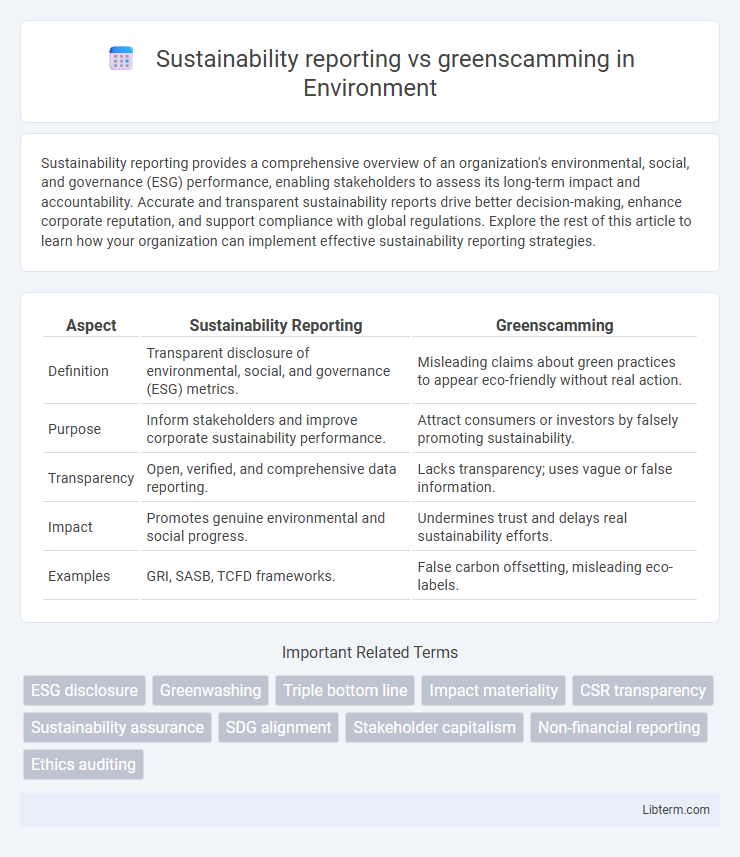Sustainability reporting provides a comprehensive overview of an organization's environmental, social, and governance (ESG) performance, enabling stakeholders to assess its long-term impact and accountability. Accurate and transparent sustainability reports drive better decision-making, enhance corporate reputation, and support compliance with global regulations. Explore the rest of this article to learn how your organization can implement effective sustainability reporting strategies.
Table of Comparison
| Aspect | Sustainability Reporting | Greenscamming |
|---|---|---|
| Definition | Transparent disclosure of environmental, social, and governance (ESG) metrics. | Misleading claims about green practices to appear eco-friendly without real action. |
| Purpose | Inform stakeholders and improve corporate sustainability performance. | Attract consumers or investors by falsely promoting sustainability. |
| Transparency | Open, verified, and comprehensive data reporting. | Lacks transparency; uses vague or false information. |
| Impact | Promotes genuine environmental and social progress. | Undermines trust and delays real sustainability efforts. |
| Examples | GRI, SASB, TCFD frameworks. | False carbon offsetting, misleading eco-labels. |
Understanding Sustainability Reporting
Sustainability reporting involves the transparent disclosure of a company's environmental, social, and governance (ESG) practices and impacts, enabling stakeholders to assess corporate responsibility accurately. Greenscamming, in contrast, refers to misleading claims where organizations exaggerate or falsify their sustainability efforts to appear environmentally friendly without substantial actions. Understanding sustainability reporting requires scrutinizing verified data, adherence to recognized frameworks like GRI or SASB, and distinguishing genuine corporate transparency from deceptive greenwashing tactics.
What Is Greenscamming?
Greenscamming refers to deceptive practices where companies falsely portray their products, policies, or operations as environmentally friendly to attract consumers and investors. Sustainability reporting aims to provide transparent, verified data on environmental, social, and governance (ESG) performance, promoting accountability and genuine progress. Unlike authentic sustainability reports, greenscamming undermines trust by exaggerating or fabricating eco-friendly claims without credible evidence or adherence to recognized standards.
Key Differences Between Sustainability Reporting and Greenscamming
Sustainability reporting involves transparent disclosure of a company's environmental, social, and governance (ESG) practices based on recognized standards like GRI or SASB, enabling stakeholders to assess genuine impact. Greenscamming, in contrast, uses deceptive marketing tactics to falsely portray a company or product as environmentally responsible without substantial evidence or measurable outcomes. Key differences include the authenticity and verifiability of claims, adherence to standardized reporting frameworks, and the transparency level regarding environmental performance.
Importance of Transparent Sustainability Practices
Transparent sustainability practices build trust with stakeholders by providing accurate, verifiable data on environmental and social impacts, distinguishing genuine efforts from greenscamming tactics. Sustainability reporting frameworks like GRI and SASB offer standardized metrics that enhance accountability and comparability across organizations. Companies prioritizing transparency reduce reputational risks, attract responsible investors, and contribute to long-term environmental and social value creation.
Common Tactics Used in Greenscamming
Common tactics used in greenscamming include misleading environmental claims, selective disclosure of positive data, and the use of ambiguous language to exaggerate sustainability efforts. Companies may also engage in greenwashing by promoting minor eco-friendly initiatives while ignoring larger environmental impacts. These deceptive practices undermine the credibility of genuine sustainability reporting and mislead consumers and investors.
How to Spot Greenscamming in Corporate Reports
Sustainability reporting transparently discloses a company's environmental, social, and governance (ESG) impacts using verified data and third-party audits, while greenscamming involves misleading or exaggerated claims designed to enhance corporate image without substantive action. Key indicators of greenscamming in corporate reports include vague or generic language lacking specific metrics, absence of third-party verification, and selective disclosure of positive results while omitting significant environmental risks or failures. Scrutinizing alignment with recognized frameworks such as GRI, SASB, or TCFD and cross-referencing reported data with independent environmental assessments helps detect inconsistencies and improve trustworthiness in sustainability claims.
Best Practices for Authentic Sustainability Reporting
Authentic sustainability reporting requires transparent disclosure of environmental, social, and governance (ESG) metrics, verified through third-party audits to ensure credibility and prevent greenscamming. Best practices include setting clear, measurable goals aligned with global frameworks such as the Global Reporting Initiative (GRI) and the Sustainability Accounting Standards Board (SASB), and providing detailed progress updates to demonstrate accountability. Companies must engage stakeholders meaningfully and avoid vague language or greenwashing tactics to maintain trust and deliver genuine impact.
Regulatory Frameworks and Greenwashing Prevention
Regulatory frameworks such as the EU Non-Financial Reporting Directive (NFRD) and the Corporate Sustainability Reporting Directive (CSRD) establish mandatory sustainability reporting standards to enhance transparency and accountability in corporate environmental disclosures. These regulations aim to prevent greenwashing by requiring verifiable data on environmental, social, and governance (ESG) impacts, ensuring companies provide accurate and comparable sustainability information. Enforcement mechanisms and third-party audits embedded in these frameworks help mitigate greenscamming risks by penalizing misleading claims and promoting genuine sustainable business practices.
The Business Case for Genuine Sustainability
Sustainability reporting provides transparent data on environmental, social, and governance (ESG) performance, building investor trust and enhancing brand value. Greenwashing, or greenscamming, distorts this information, misleading stakeholders and risking regulatory penalties and reputational damage. Genuine sustainability efforts drive operational efficiency, reduce costs, and open access to ESG-focused capital markets, creating a strong business case grounded in long-term value creation.
Building Stakeholder Trust Through Verified Reporting
Verified sustainability reporting fosters stakeholder trust by providing transparent, accurate, and credible data on environmental and social impacts. This contrasts with greenscamming, where misleading or exaggerated claims damage reputation and erode confidence. Robust third-party audits and adherence to global frameworks like GRI and SASB enhance accountability and demonstrate genuine commitment to sustainable practices.
Sustainability reporting Infographic

 libterm.com
libterm.com